
I had a long and rainy drive from Hyde Park, NY to Boston to figure out what to write about the boot camp program at the CIA. But as I stumbled through my front door, soaked and tired, I still didn’t know where to begin. I was happy to be home, happy to be with Jason, happy to be in my own kitchen. As we were finishing our dinner of grilled mahi and braised fennel that Jason so lovingly prepared to welcome me home, I must have gotten unusually quiet and if you’ve ever met me in person, you’d know that quiet is not my normal state. "You have to promise me something," said Jason. "Promise that you'll tell the truth on your blog." The problem is that the truth is not always a comfortable thing to tell, particularly when talking about famous restaurants, chefs, and culinary schools, but I’ll do my best.
In stead of recounting events day by day as they happened, I am organizing my thoughts by topic. I doubt all the topics will fit into one post – as you know I have an opinion about pretty much everything, but one has to start somewhere.
Campus:
The campus is absolutely stunning. It was a Jesuit seminary until the 70's, which gives the place its grandeur and lore. During our tour, we learned all kinds of interesting bits of trivia, like the fact that the meat room is where Jesuit crypts used to be and that the main dining hall used to be a chapel. The courtyards, the fountains, the ivy clad walls, and the number of people running around in uniforms makes you feel like you are in Hogwarts of pastry and cookery (as Tasting Menu so accurately named it).

The fountain in the courtyard of Roth Hall (the main building above)

Colavita center for Italian food and wine and restaurant Caterina de' Medici

Student Dining Hall
All kitchens and classrooms have glass windows on the hallway facing wall. This allows tours to peek in without disturbing classes. At first, it felt weird to have people staring at you as you chop your onions, but after a few days we got used to it.

When it was our turn to go on a tour, we got to peek in on a mushroom identification class.
The students:
There were 15 students participating in the boot camp program. 13 from US, 1 from Canada, and 1 from Mexico. The experience ranged from complete beginner to experienced home cooks. We were divided into 5 teams of 3. The lectures and demos were done with the whole class, but cooking assignments were different for each team. Here is our team #5:

from left to right: Mark, Helen (that's me), George
Schedule:
Our days looked roughly like this:
6:30 - 7 Meet with your team to plan how to cook that day’s dishes
7 - 8:30 Lecture
9 - 10 Demo by the chef
10 - 12 Each team cooks the dishes assigned to them that day
12 - 1 Eat what we cooked for lunch
1 - 1:30 Chef reviews our dishes
2 - 4 Wine tasting OR food and wine pairing OR more cooking lecture
6:30 - 9 Dinner in one of CIA’s restaurants
Topics we covered:
Day 1: Knife skills and stocks
Day 2: Dry heat techniques (sauté, pan-fry, deep-fry), soups, and thickening agents
Day 3: Dry heat techniques without fats (grilling, broiling, roasting)
Day 4: Moist heat cooking (braising and poaching)
Day 5: Final project (each team was given 2 main ingredients and we had to come up with an appetizer and entrée to feature those).
The instructor:
Ok, so maybe I got a little put off when our chef instructor, told us he hates sushi and wants all fish to be cooked through, but I must say, he was a wonderful teacher. He managed to keep us on our toes and laughing at 7 am 5 days in a row. His mother-in-law played a large part in making sure we were well entertained as she appeared in a number of hilarious stories about turkey, risotto, and most of the basic cooking techniques.
Lectures and Demos:
Unfortunately, I didn’t learn much during lectures. Maybe it’s because I already understood the basic cooking techniques, or maybe because I learn better by watching than by listening. That’s why the demo was my favorite part of the class. The chef would pick out a few of the dishes we were cooking that day and demonstrated how to make them. That's where I picked up all kinds of little tips and tricks like how to tie a butcher’s knot, how to keep risotto from turning gummy, how to unroll pasta ribbons when cutting them by hand, etc. I just couldn’t help wishing that we drop the useless lecture and spend that time on demos and hands-on work. For example, the knife skills demo and practice only covered veggies (no deboning a chicken, filleting a fish, or trimming meat). The stocks were discussed in lecture, but we didn’t get to make them, which was a shame as I was really looking forward to that. Same for the sauces and thickeners – just lecture, but no demo or practice.
Plate presentation:
When we only had one week to go through all the basic cooking methods, the last thing I expected them to spend time on was presentation. But that’s what took up a whole lecture the first afternoon and that’s how our plates were critiqued every day – based on how they looked, not how they tasted. When you think about it from the professional cook’s point of view, it makes perfect sense. Customers eat with their eye. Few can tell if your dish is slightly under-seasoned or overdone, but everyone can tell if your grill marks are in the right place and if the food looks “gourmet" vs homey. When you realize that you can charge twice as much for the same dish in a restaurant if you make it look a little taller and place it on a plate with a wide rim, you start paying attention to this stuff. Of course, I don’t cook in a restaurant, so this stuff didn’t feel particularly interesting to me, but learning it didn't hurt. Here is what we learned about presentation:
• Don’t put your ingredients into different corners of a plate like a TV dinner.
• Create a central focus point (everything should overlap).
• Give your food some height, but not too much.
• Make sure all garnishes are edible (no rosemary or parsley sprigs).
• Use contrasting colors and textures.
• Nothing should touch the rim of the plate – the rim is like a frame of a painting.
Of course, as soon as you start creating rules, the really “cool” people start breaking them. Have you noticed how some of the more upscale restaurants started putting different parts of a dish into different corners of a plate and making food look really flat. These days, the TV dinner or deconstructed food is the new chic look. It’s just that the culinary schools didn’t catch up to it yet. Just like fashion, it goes in circles.
I must say that by the 5th day, our food looked like a brunch buffet at an upscale hotel, but still didn’t taste much better than a good cafeteria. Though, then again, that's what a buffet at most hotels tastes like.
Of course a lot of this could be explained by cooking in unfamiliar kitchen with 15 other people running around trying to locate their equipment and ingredients. I am sure many of these dishes would have tasted much better if we were cooking them in our own kitchens. But the fact that the emphasis of the class was on looks and timing and not on the taste didn’t help. In fact, the only explanation of doneness was to use a thermometer and the only explanation of seasoning was to add “enough” salt.

What did we cook? Come back tomorrow to find out.

 I am one of those weird people who love school. I remember one day in 9th grade, crying because summer was coming and that meant no more classes, notebooks, graph paper, freshly sharpened pencils, or problem sets. I know, there is help for people like me, but I’ve never looked into it. Instead, I spent ridiculous number of years in school studying subjects I had no clue about, but that sounded like they might make a good career.
I am one of those weird people who love school. I remember one day in 9th grade, crying because summer was coming and that meant no more classes, notebooks, graph paper, freshly sharpened pencils, or problem sets. I know, there is help for people like me, but I’ve never looked into it. Instead, I spent ridiculous number of years in school studying subjects I had no clue about, but that sounded like they might make a good career.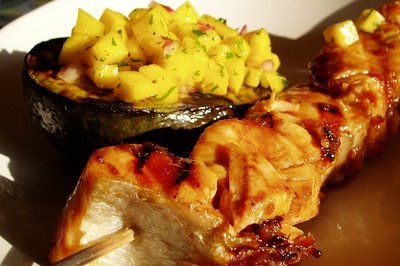 Last week, we’ve been eating soup, soup, and more soup. To combat the never ending rain, I went on a soup binge and made every soup I’ve been meaning to try but never got around to:
Last week, we’ve been eating soup, soup, and more soup. To combat the never ending rain, I went on a soup binge and made every soup I’ve been meaning to try but never got around to:  Boston is turning into Seattle, except that our coffee still sucks and sushi could definitely be better. A week of non-stop rain is really getting to us here, which made me reach for the secret weapon to cure the wetness blues – soup. After going through my mental list of “soups to try” I settled on creamy parsnip soup. I had such a wonderful version at a local café for lunch recently, that I was inspired to try it at home. The process of making it is not much different from turnip soup, celery root soup, or any other creamy root vegetable soup. The trick is to cook parsnips long enough to make them very tender, this ensures that the resulting soup will be smooth and creamy.
Boston is turning into Seattle, except that our coffee still sucks and sushi could definitely be better. A week of non-stop rain is really getting to us here, which made me reach for the secret weapon to cure the wetness blues – soup. After going through my mental list of “soups to try” I settled on creamy parsnip soup. I had such a wonderful version at a local café for lunch recently, that I was inspired to try it at home. The process of making it is not much different from turnip soup, celery root soup, or any other creamy root vegetable soup. The trick is to cook parsnips long enough to make them very tender, this ensures that the resulting soup will be smooth and creamy. I find the question, “So how did you learn to cook?” and circumstances under which it’s asked kind of rediculous. People ask me that so casually and so often you’d think it’s as straightforward as “What’s the weather?” “Where do you live?” and “Who are the Red Sox playing tonight?”
I find the question, “So how did you learn to cook?” and circumstances under which it’s asked kind of rediculous. People ask me that so casually and so often you’d think it’s as straightforward as “What’s the weather?” “Where do you live?” and “Who are the Red Sox playing tonight?”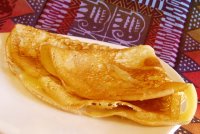

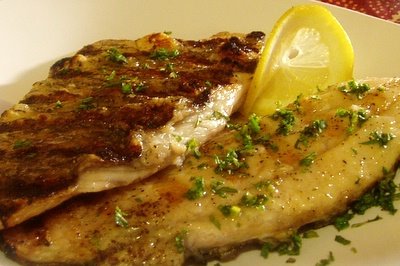 I just realized that there is one more day left before the
I just realized that there is one more day left before the 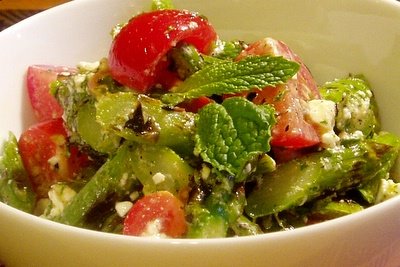
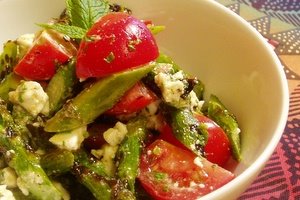
 The
The 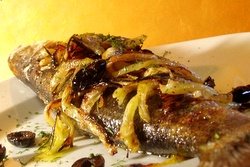
 My parents used to joke that if you mixed my brother and me up, stirred really well, and then divided the mixture into two part, you’d end up with two perfect kids: responsible, but not obsessive; willing to explore the world, but always sure to return home; extremely career-driven, but putting family first. Too bad there is no way to achieve such perfection when it comes to people. People come with their strengths and weaknesses and there is not much you can do about that. But when it comes to cooking – anything’s possible.
My parents used to joke that if you mixed my brother and me up, stirred really well, and then divided the mixture into two part, you’d end up with two perfect kids: responsible, but not obsessive; willing to explore the world, but always sure to return home; extremely career-driven, but putting family first. Too bad there is no way to achieve such perfection when it comes to people. People come with their strengths and weaknesses and there is not much you can do about that. But when it comes to cooking – anything’s possible.
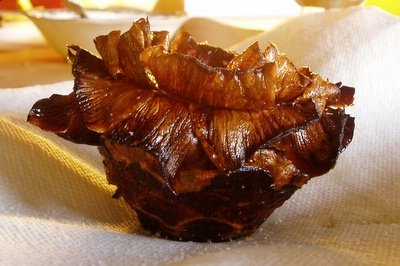 I’ve been one frustrated little food blogger lately. Some dishes of last week had good pictures, some had good stories, and some actually tasted good. But none had all three qualities that inspire you to write. It all started with my attempt to make carciofi alla giudia (deep-fried artichokes). I fell under the spell of this rose bud looking dish on our trip to Rome, but have never attempted it at home until a recent post on
I’ve been one frustrated little food blogger lately. Some dishes of last week had good pictures, some had good stories, and some actually tasted good. But none had all three qualities that inspire you to write. It all started with my attempt to make carciofi alla giudia (deep-fried artichokes). I fell under the spell of this rose bud looking dish on our trip to Rome, but have never attempted it at home until a recent post on 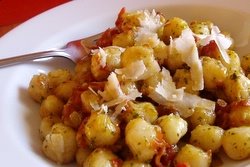 The good news is that I learned to trim artichokes. The bad news is that dropping artichokes covered in lemon juice into hot oil resulted in an oil explosion and the biggest mess my kitchen has ever seen. I was lucky my oil didn’t inflame! So, kids don’t try this at home. I ended up with a burnt artichoke and half an hour of degreasing my stove, counter and floor. So the story of “Helen conquers her fear of deep-frying and learns to cook artichokes to bring back the taste of Rome” turns into “Helen almost sets her kitchen on fire in spite of having the guidance of 3 recipes.” Good thing I made some gnocchi with roasted tomato sauce. They made a good comfort food dish after the artichoke disaster.
The good news is that I learned to trim artichokes. The bad news is that dropping artichokes covered in lemon juice into hot oil resulted in an oil explosion and the biggest mess my kitchen has ever seen. I was lucky my oil didn’t inflame! So, kids don’t try this at home. I ended up with a burnt artichoke and half an hour of degreasing my stove, counter and floor. So the story of “Helen conquers her fear of deep-frying and learns to cook artichokes to bring back the taste of Rome” turns into “Helen almost sets her kitchen on fire in spite of having the guidance of 3 recipes.” Good thing I made some gnocchi with roasted tomato sauce. They made a good comfort food dish after the artichoke disaster.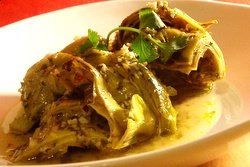 But I was determined not to give up on artichokes. I got some more the next day and decided to braise them. By now, I was getting pretty good at trimming them (I went through a lot of artichokes this weekend) and this time the cooking was less dramatic. I poured a little oil into a hot pan, added artichokes, garlic, parsley, lemon zest, juice and water. Then covered the pan and cooked on low for 10 minutes. This time, the artichokes were quite decent, but not much better than the canned. So I am still on a search for a great artichoke recipe. If you know of one, please let me know.
But I was determined not to give up on artichokes. I got some more the next day and decided to braise them. By now, I was getting pretty good at trimming them (I went through a lot of artichokes this weekend) and this time the cooking was less dramatic. I poured a little oil into a hot pan, added artichokes, garlic, parsley, lemon zest, juice and water. Then covered the pan and cooked on low for 10 minutes. This time, the artichokes were quite decent, but not much better than the canned. So I am still on a search for a great artichoke recipe. If you know of one, please let me know.  My other cooking experiment involved making pissaladière (a Provencal pizza with caramelized onions, olives, and anchovies). For the first time in my life, I botched up the toppings, not the dough. I am still in shock about it. For the dough, I used Reinhart’s recipe for focaccia and it turned out extremely well, but by the time the dough was done, the toppings got a little burnt (anchovies got particularly nasty). Of course, getting a recipe would probably be a good idea, but who thought you’d need a recipe for toppings!
My other cooking experiment involved making pissaladière (a Provencal pizza with caramelized onions, olives, and anchovies). For the first time in my life, I botched up the toppings, not the dough. I am still in shock about it. For the dough, I used Reinhart’s recipe for focaccia and it turned out extremely well, but by the time the dough was done, the toppings got a little burnt (anchovies got particularly nasty). Of course, getting a recipe would probably be a good idea, but who thought you’d need a recipe for toppings! Luckily, I saved half of the dough and made a regular focaccia with it tonight. It was unbelievably close to what I had in Liguria.
Luckily, I saved half of the dough and made a regular focaccia with it tonight. It was unbelievably close to what I had in Liguria.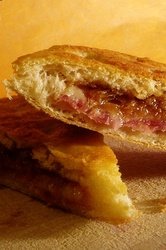 We put some fig jam, prosciutto, cheddar, and leftover caramelized onions inside and made grilled sandwiches that were so good, they redeemed all the weekend’s disasters.
We put some fig jam, prosciutto, cheddar, and leftover caramelized onions inside and made grilled sandwiches that were so good, they redeemed all the weekend’s disasters.